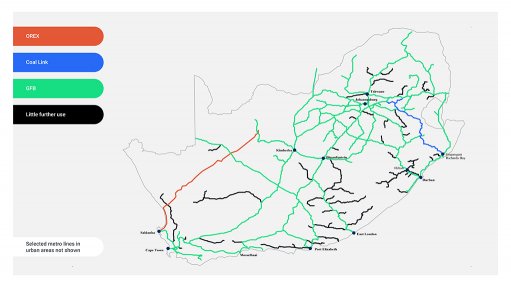
Photo by: Supplied by ARIA
Government is committed to creating a competitive and efficient freight transport system in South Africa as a matter of priority. This includes allowing third party access to South Africa’s rail system, finalising the whitepaper on national rail policy, and the establishment of a single transport economic regulator.
However, it was not necessary to wait for the establishment of the regulator or the finalisation of the national rail policy to allow third-party access to the country’s rail network, said Sean Phillips, head of the National Treasury’s Operation Vulindlela unit, which is tasked with accelerating structural reforms.
Speaking at a webinar hosted by the African Rail Industry Association (ARIA) this week, Phillips said the current target date for enabling third-party operators in the freight sector was August 2022, with ongoing efforts under way to accelerate the time frame put on the table by Transnet.
“Government is moving in a direction of enabling more private sector participation in sectors like ports and freight rail, with the aim of increasing competition. This will result in a more competitive freight transport environment, and more reliable and better-quality freight transport services,” said Phillips.
The moves follow President Cyril Ramaphosa’s announcement last October of structural reforms to allow private rail operators to operate on South Africa’s core rail network (third-party access) to supplement Transnet’s capacity and assist in migrating freight volumes from road to rail, as well as to stimulate economic growth.
Mesela Nhlapo, the CEO of ARIA, said opening South Africa’s rail infrastructure to third party operators would provide a multi-billion rand boost to the country’s economy over the next five years, potentially creating thousands of jobs and driving massive economic benefits. At the same time, state-owned rail operator Transnet would derive a material new income stream through access fees, without having to go into competition with private rail operators.
“The table is set for the practical implementation of third-party access. No new regulation or legislation is required for implementation, South Africa’s unutilised track network capacity is vast, and there is a body of around 58 million tonnes per annum of freight that will move to rail when rail capacity grows, benefiting sectors like agricultural commodities, metals and minerals, cars, containers, hazardous chemicals and liquid bulk,” said Nhlapo.
Early projections by ARIA suggest that additional parties using the rail network rail will create tens of thousands of upstream jobs by enabling industry (like smelters, steel mills, manufacturing and agri processing) and mining (new coal, manganese and iron ore mines, amongst others) to become internationally competitive. Similarly, rail corridors into Africa would create cost-effective gateways to take South African goods into these markets.
A prime example of using logistics infrastructure to drive economic growth is Australia, which went from exporting around 100 million tonnes per annum of iron ore in 1995 to 867 million tonnes in 2020. This has generated billions of dollars of revenue for the Australian fiscus, with iron ore comprising around 65% of the economy of western Australia and supplying 100,000 jobs. This was achieved through private sector investment while South Africa has largely missed out on the commodity super cycles.
Speaking during the webinar, James Holley, the CEO of independent rail operator Traxtion, said opening the rail network to third-party operators would unlock billions of rands in industry investments almost immediately. Investment in new trains is anticipated to be in the region of R45bn, the vast majority of which would be manufactured in South Africa.
Traxtion has already announced an initial locomotive and wagon build programme of R1.5 billion, with plans to invest a further R14-17 billion in locomotives and wagons over the next five years as part of a carefully scaled rolling procurement programme.
Issued by The African Rail Industry Association